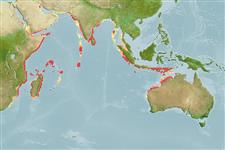Common names from other countries
Environment: milieu / climate zone / depth range / distribution range
Ökologie
seewasser riff-verbunden; standorttreu; tiefenbereich 1 - 25 m (Ref. 9710). Tropical
Western Indian Ocean: Gulf of Aden to Natal, South Africa and including Seychelles, Comoros and Madagascar.
Size / Gewicht / Alter
Maturity: Lm ? range ? - ? cm
Max length : 33.0 cm SL Männchen/unbestimmt; (Ref. 30573)
Rückenflossenstacheln (insgesamt): 13 - 14; Rückenflossenweichstrahlen (insgesamt): 17-19; Afterflossenstacheln 3; Afterflossenweichstrahlen: 18 - 19. Juveniles with stripes on head (Ref. 5953).
Inhabits coral-rich reefs (Ref. 9710). Seldom seen in the aquarium trade.
Life cycle and mating behavior
Geschlechtsreife | Fortpflanzung | Ablaichen | Eier | Fecundity | Larven
Allen, G.R., 1985. Butterfly and angelfishes of the world. Vol. 2. 3rd edit. in English. Mergus Publishers, Melle, Germany. (Ref. 4858)
IUCN Rote Liste Status (Ref. 130435)
CITES (Ref. 128078)
Not Evaluated
Bedrohung für Menschen
Harmless
Nutzung durch Menschen
Aquarium: Kommerziell
Mehr Information
NamenSynonymeMetabolismusRäuberÖkotoxikologieFortpflanzungGeschlechtsreifeAblaichenFecundityEierEientwicklung
ReferenzenAquakulturAquakultur ProfilZuchtlinienGenetikElectrophoresesVererbbarkeitKrankheitenVerarbeitungMass conversion
Tools
Zusatzinformationen
Download XML
Internet Quellen
Estimates based on models
Preferred temperature (Ref.
115969): 26 - 28.9, mean 27.5 (based on 532 cells).
Phylogenetic diversity index (Ref.
82804): PD
50 = 0.5001 [Uniqueness, from 0.5 = low to 2.0 = high].
Bayesian length-weight: a=0.03236 (0.01300 - 0.08052), b=2.89 (2.71 - 3.07), in cm Total Length, based on LWR estimates for this Genus-body shape (Ref.
93245).
Trophic level (Ref.
69278): 2.6 ±0.00 se; based on food items.
Widerstandsfähigkeit (Ref.
120179): niedrig, Verdopplung der Population dauert 4,5 - 14 Jahre. (Preliminary K or Fecundity.).
Fishing Vulnerability (Ref.
59153): Low to moderate vulnerability (30 of 100).
